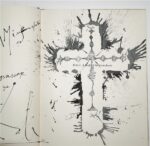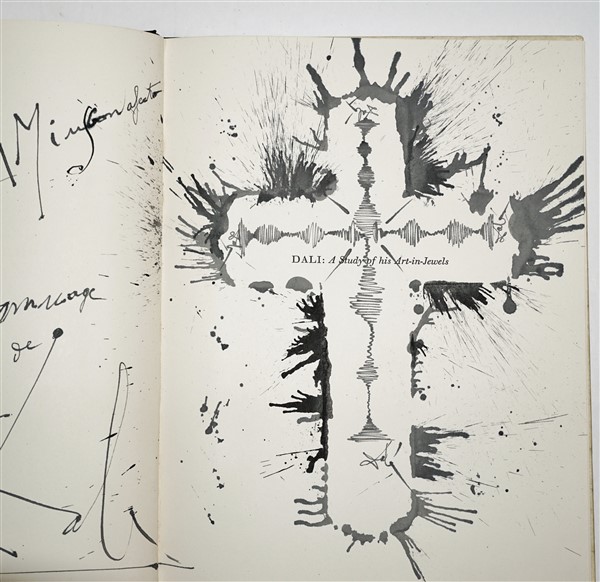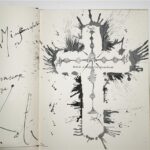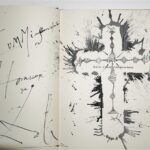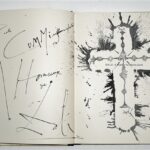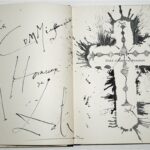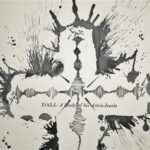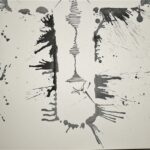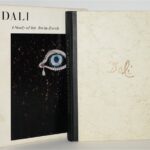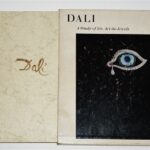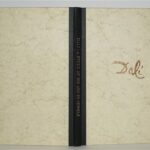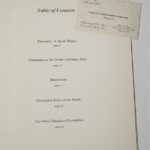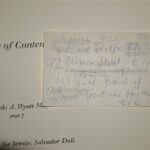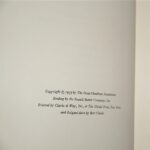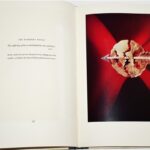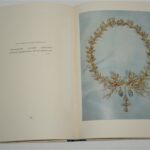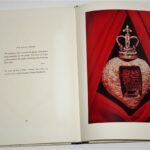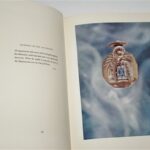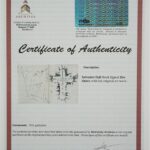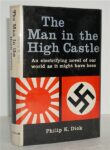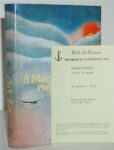SALVADOR DALI, 1904-1989
Greenwich: New York Graphic Society. 1959. First Edition. An important association copy with spectacular museum quality original art by Salvador Dali!.
This copy is elaborately signed and inscribed with an ENORMOUS CRUCIFIX DRAWING by Dali across two pages “Pour Cummins con afecto / Hommage / de / Dali”. Dali SIGNED and Inscribed the book to Cummins Catherwood (see Bio below), and then additionally embellished the adjacent page with an extraordinary large ink illustration of a crucifix. EACH POINT OF THE CROSS IS ADDITIONALLY SIGNED by Salvador Dali, representing FOUR additional signatures “Dali”.. The book will be accompanied by the card of Carlos Bernardo Alemany, the Argentinean jeweler craftsman who uniquely and personally hand produced all of the Salvador Dali jewelry (While the jewelry designs were entirely created by Dalí, the pieces themselves were crafted by Argentinian jeweler Carlos Alemany.). The card is shown with various notations on the verso in an unknown hand. Both the book and case in fine condition throughout. Deluxe hard cover edition, 67 pp. with numerous tipped-in color plates, contained in a slipcase. The book dimensions are 11.5″ x 9″
The first of Dali’s jewelry designs were produced in 1941 and the first collection of 22 of these were acquired by the American millionaire Cummins Catherwood, to whom the present volume is inscribed. Dali designed the pieces on paper, with all sorts of details and very precise shapes, materials and colours, while the actual making of the jewels was carried out in New York, under the attentive supervision of the artist, in the studio of Carlos Alemany, a gold/silversmith of Argentinian origin. In 1958 the jewels were acquired by the Owen Cheatham Foundation, a prestigious American foundation created in 1934, which would lend out the jewel collection so that various charitable, educational and cultural entities could collect funds by exhibiting it. Eventually deposited at the Virginia Museum of Fine Arts, the collection was later sold a number of times before eventually being acquired by the Dali Foundation. The artist wrote that “in jewels, and in all my artistic activity, I create what I love most. In some of them one can discern an architectural meaning, as it also happens in some of my paintings. Once again, the logarithmic law is highlighted, as well as the interrelation between spirit and matter, between space and time.”
BIOGRAPHY OF CUMMINS CATHERWOOD:
In 1949, the Philadelphia banker and philanthropist Cummins Catherwood and his wife Ellengowen commissioned 22 pieces of jewelry, including the legendary “Eye of Time”, directly from Salvador Dalí, as both patrons, and later friends, of the artist. The couple would review Dali’s paper sketches of the jewels before the execution in diamond, platinum and precious gems. The Catherwoods were also friends with the artist Rudolgph von Ripper, a collaborator of the Argentinian jeweler Carlos Alemany, whom Dalí entrusted with making the limited number of these pieces under his strict observation. The Catherwoods displayed their extensive Dalí collection, which included works on paper and bespoke jewels in the living room of their Haverford, Pennsylvania mansion, where they later received a visit from Dalí himself.
**A superb and extremely scarce original ink drawing, signed 5 times by Salvador Dali (4 times within the Crucifix and once within the inscription dedication), with an important association to Cummins Catherwood. Examples of the scarce original Dali drawing has escalated in price over the last 5 years, with the few other examples of original Dali artwork of this magnitude selling at auction for $50,000.00. The piece will come with a Certificate of Authenticity (LOA/COA), from University Archives, John Reznikoff, who is the of the premier authenticators for PSA, James Spence and numerous auction houses. (see images)
SALVADOR DALI BIOGRAPHY:
The psychoanalytic theories of Sigmund Freud grounded the artistic pursuits of the Surrealists. Freud’s work was especially important to Dalí, whose family life could not have been more in need of an analyst’s couch. Dalí was named after his older brother Salvador, who had died nine months before his birth. His parents believed that Dalí was his brother’s reincarnation, leaving the artist with the feeling that it was not he, but rather the memory of his older brother who was loved by his parents. When Dalí was a teenager, his mother died from cancer, and four years later his father married his mother’s sister, Tieta.
Dalí’s tumultuous family life escalated yet again in 1929, when Dalí titled one of his paintings Sometimes I Spit with Pleasure on the Portrait of my Mother (The Sacred Heart), which so angered Dalí’s father that he expelled the artist from the family. These events underlie some of his darkest and most disturbing paintings, and his personal history would continually surface in his iconography, as objects from his past were later re-imagined as opened drawers, decaying foods, and melting clocks. “The only difference between immortal Greece and the present time,” explained Dalí, “is Sigmund Freud, who discovered that the human body…is today full of secret drawers that only psychoanalysis is capable to open.”
While his celebrity persists, it’s perhaps more surprising that Dalí’s paintings continue to shock audiences half a century after their creation. While many of his avant-garde contemporaries have lost their taboo factor, Dalí’s works are still disturbing to the modern eye, as viewers seek to uncode their grotesque, dreamlike contents. “The only difference between me and a madman,” Dalí famously once quipped, “is that I am not mad.”
Today Dali’s art is found within every significant art museum worldwide, his originals are quite scarce. HIGH RESOLUTION IMAGES AVAILABLE UPON REQUEST.

